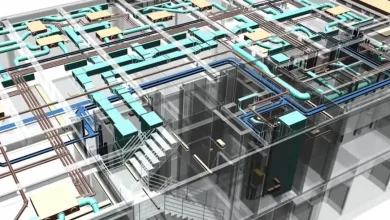Table of Contents
Building Information Modeling (BIM) characterizes the construction sector, as it is a mandatory requirement for the awarding of contracts in many countries
The goal is to achieve efficient project management. The prerequisites for achieving it are transparency, good communication and interdisciplinary collaboration.
The attention is focused on the digital model of the building which contains all the information from the various disciplines. By now everyone knows that BIM is not a software, but a working method for the construction sector where people, processes and tools cooperate in a goal-oriented way. In theory, this all sounds simple, but for designers it presents a great challenge. In particular, the exchange of CAD data in the past proved to be imperfect with the conventional working method. The exchange of different formats between the various software of the different disciplines has often caused a loss of information
The IFC format, consisting of neutral data, has been developed to ensure a smooth BIM process
All BIM-compatible design solutions on the market (mainly Allplan, ARCHICAD, Vectorworks and Autodesk Revit) work with proprietary file formats. In order to lay the foundation for the smoothest possible data exchange in today’s BIM process, a shared file format is needed; a common language. The first stone had already been laid in 1995 with the “International Alliance for Interoperability” (IAI), when there was still no talk of BIM (Building Information Modeling).
At the time, the first 3D models were spread out among the pioneers of a few design offices. But the transfer of design data from one CAD software to another, or to competing programs, was already necessary and could also be achieved with the first versions of the IFC format. Since then, the IFC exchange interface has accompanied designers through the evolution of construction processes and, with the introduction of BIM into the daily design routine, it has become more important than ever.
IFC and buildingSMART are closely linked
The IAI organization was created by the initiative of leading software development companies with the aim of advancing 3D model-based design methods (still a novelty in the 1990s and 2000s) to improve exchange data through optimized IT interfaces. In 2005, the name was then changed to buildingSMART. The international organization now has 550 members and is active in 24 countries. In addition to the important task of optimizing the interface, the members work closely on further developing and standardizing parameters for the open exchange of information between software in BIM projects. The IFC format is the essential means of transport in achieving this goal.
The “buildingSMART International Spring Summit” in April 2017 heralded a new era for the IFC format. One of the highlights was the adoption of a “Memorandum of Understanding” (MoU), whereby railway companies from seven countries decided to develop an IFC standard for railway operations by mid-2019. They are currently working on standards and interfaces to achieve the same full flow of information in engineering projects as well
In the BIM process, the IFC supports the flow of data between designers and software, connecting the BIM model with the partial models of the specialized disciplines. It also takes into account working methods and the necessary flow of information between project participants. Typically, an architect works mainly with design software programs compatible with the BIM method for the development of their projects; the engineer uses another type of software for static calculation and visualization of trends, as well as for the reinforcement design, while the designer of the building’s technical systems works in yet another application. The various sub-projects must then be combined again (i.e. federated) in the BIM model via the IFC format.
The IFC interface is also available in applications to participate in contests for the award and invoicing (calculation of volumes and costs) and to import and interpret specific information relating to competitions. In addition, the BIM-compatible design software offers relevant information for planning times and deadlines, as well as for controlling costs and construction processes (which in the BIM method are made possible by the IFC format). The advantages of the BIM design method and the IFC interface extend to the production of prefabricated elements and numerically controlled components.
Machine control programs linked via IFC evaluate modeled geometry, interpret it for the machine’s work processes and translate it into a real product.





